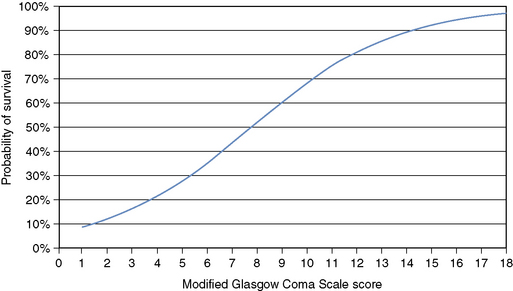Chapter 97 Coma Scales
INTRODUCTION
Appropriate therapy for patients with head trauma remains controversial in veterinary medicine (see Chapter 152, Traumatic Brain Injury). Treatment must be immediate if the animal is to recover to a level that is both functional and acceptable to the owner. It is important therefore to be aware of the optimal way to assess these patients; many dogs and cats can recover from severe brain injuries if the clinician is able to identify treatable systemic and neurologic abnormalities in a timely manner.
MODIFIED GLASGOW COMA SCORING SYSTEM
A modification of the Glasgow Coma Scale used in humans has been proposed for use in veterinary medicine.4 This scoring system enables grading of the initial neurologic status and serial monitoring of the patient. Such a system can facilitate the assessment of prognosis, which is crucial information for both the veterinarian and owner.4 An almost linear correlation between this scoring system and survival of dogs with head trauma has now been evaluated (Figure 97-1).5 It should be noted that long-term survival and functional outcome have not been evaluated using these scales in dogs or cats.
Each of the three categories of the examination (i.e., level of consciousness, motor activity, brain stem reflexes) is assigned a score from 1 to 6 (Table 97-1). The level of consciousness provides information about the functional capabilities of the cerebral cortex and the ascending reticular activating system in the brain stem.6
Table 97-1 Small Animal Modified Glasgow Coma Scale
| Assessment Parameter | Score |
|---|---|
| Motor Activity | |
| Normal gait, normal spinal reflexes | 6 |
| Hemiparesis, tetraparesis, or decerebrate activity | 5 |
| Recumbent, intermittent extensor rigidity | 4 |
| Recumbent, constant extensor rigidity | 3 |
| Recumbent, constant extensor rigidity with opisthotonus | 2 |
| Recumbent, hypotonia of muscles, depressed or absent spinal reflexes | 1 |
| Brain Stem Reflexes | |
| Normal pupillary light reflexes and oculocephalic reflexes | 6 |
| Slow pupillary light reflexes and normal to reduced oculocephalic reflexes | 5 |
| Bilateral, unresponsive miosis with normal toreduced oculocephalic reflexes | 4 |
| Pinpoint pupils with reduced to absent oculocephalic reflexes | 3 |
| Unilateral, unresponsive mydriasis with reduced to absent oculocephalic reflexes | 2 |
| Bilateral, unresponsive mydriasis with reduced to absent oculocephalic reflexes | 1 |
| Level of Consciousness | |
| Occasional periods of alertness and responsiveness to environment | 6 |
| Depression or delirium, capable of responding but response may be inappropriate | 5 |
| Semicomatose, responsive to visual stimuli | 4 |
| Semicomatose, responsive to auditory stimuli | 3 |
| Semicomatose, responsive only to repeated noxious stimuli | 2 |
| Comatose, unresponsive to repeated noxious stimuli | 1 |
A score is given to each of three categories of the neurologic examination: motor activity, brain stem reflexes, and level of consciousness. Within each category, a score of 1 to 6 exists, representing the most severe to the mildest of clinical pictures. A total score can then be helpful (1) in estimating the severity of the initial condition, which determines the most appropriate level of therapy, (2) assessing the prognosis for survival within the first 72 hours, and (3) assessing the effect of therapy.
Reprinted with permission from Platt SR, Radaelli ST, McDonnell JJ: The prognostic value of the modified Glasgow Coma Scale in head trauma in dogs, J Vet Intern Med 15:581, 2001.
Stay updated, free articles. Join our Telegram channel

Full access? Get Clinical Tree



